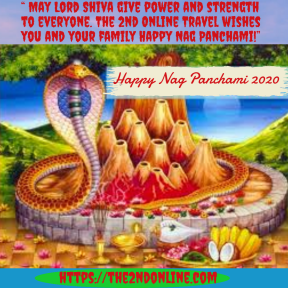Navratri Day 7th Goddess Kalratri On the seventh day of Navratri celebrations, Goddess Kalratri is worshipped. Her body is black in colour just like darkness and she has three eyes which are round shaped just like the universe. Though her appearance is fearsome but she is very auspicious. She is also considered to be very powerful. In India Kalratri Temple in Varanasi is dedicated to her. This temple is one of the Shakti peets of Varanasi. Goddess Kalratri rules Planet Rahu. The goddess has four arms and she rides on a gadarbh with donkey being her procession. Kalratri goddess has killed demons Shumbh and Nishumbh. She has 3 eyes and she exhales fire flames through her nose. Her upper right hand grants blessings and lower right hand grants protection. In her upper left hand she holds an iron thorn and her lower left hand has a dagger. Goddess Kalratri also wears a bead that glows like fire of electric power. She destroys evil and her devotees need not fear anything.Kal...
Naga Panchami is a festival that includes both Hinduism and early Indian religious beliefs. Panchami means "fifth," the day on which this Hindu festival is celebrated, and Naga refers to a group of serpent deities in early Indian religion. The mythical Nagas were semi-divine beings said to have sprung from Kadru, the wife of Rishi Kashyapa. Although they live and rule below the earth, the Nagas were believed to roam the earth wearing jewels and ornaments. SNAKE worship was fairly widespread in India at one time and is still an important part of popular religious practice in some regions. When Naga culture was incorporated into Hinduism, many of the snake deities were accepted by the Hindus into their belief systems. The thousand-headed serpent Ananta, for example, is the most powerful of the Nagas. It is on the coils of Ananta that the Hindu god Vishnu is often seen resting. Shrines to the nagas can be found throughout India, and Hindu women often worship at "snake-stones" when they want to bear sons or avoid illness.
As a festival in honor of the snake deities, Naga Panchami goes back to very ancient times. It is an occasion for fasting and worshipping cobras, since the Nagas were often depicted as cobras with extended hoods. If cobras are not available, huge cloth effigies of serpents are made and displayed in public, as are snakes made from metal, stone, and clay. Images of snake deities are often painted on walls as well. Worshippers offer milk and flowers to the cobras and coins to the snake charmers who gather in town for the festival. Because serpents live underground, digging in the earth is prohibited on this day.
As a festival in honor of the snake deities, Naga Panchami goes back to very ancient times. It is an occasion for fasting and worshipping cobras, since the Nagas were often depicted as cobras with extended hoods. If cobras are not available, huge cloth effigies of serpents are made and displayed in public, as are snakes made from metal, stone, and clay. Images of snake deities are often painted on walls as well. Worshippers offer milk and flowers to the cobras and coins to the snake charmers who gather in town for the festival. Because serpents live underground, digging in the earth is prohibited on this day.
The Hindu god Shiva is also worshipped at this festival, since he is traditionally shown wearing snakes as ornaments. In temples dedicated to Shiva, particularly those in Ujjain and Varanasi, hundreds of cobras are brought in by trappers and released before the god's image. Worshippers then empty their pots of milk over the snakes' heads to protect themselves against snakebite throughout their lives. At the end of the day, there are serpent dances in open fields, and the snakes are freed.

.png)

.png)

I admire this article for the well-researched content and excellent wording. Read more info about Service Apartments Kazhakkoottam. I got so involved in this material that I couldn’t stop reading. I am impressed with your work and skill. Thank you so much.
ReplyDelete